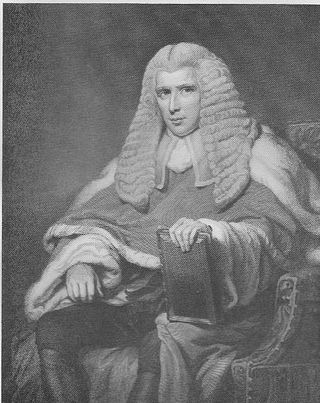Loading AI tools
English lawyer and judge From Wikipedia, the free encyclopedia
Sir Edward Hall Alderson (baptised 11 September 1787 – 27 January 1857) was an English lawyer and judge whose many judgments on commercial law helped to shape the emerging British capitalism of the Victorian era.[1]

He was a Baron of the Exchequer and so held the honorary title Baron Alderson, in print Alderson, B.
Born in Great Yarmouth, Alderson was the eldest son of Robert (died 1833), a barrister and recorder, and Elizabeth née Hurry who died in 1791. Alderson suffered an unstable childhood, variously living with relatives, unhappily attending Charterhouse School but, more positively, being tutored by Edward Maltby.[1] He was an able student of mathematics and classics at Gonville and Caius College, Cambridge, about to take exams he heard of the sad death of his sister Isabella. A year later in 1809 he graduated as senior wrangler, First Smith's prize, was First Medallist, and Chancellor's Gold Medallist. During free time he became an ardent debater and avid reader; winning Middle Bachelors, and the Latin Prize for Comparison of Ancient Dialogues with Modern. In his finals year he also won the Members Prize, and Senior Bachelors Prize. He was consequently elected fellow.[2]
A pupil of Joseph Chitty, Alderson was called to the bar in 1811 at the Inner Temple and began work on the northern circuit where he established a substantial practice. He joined with Richard Barnewall as a law reporter from 1817 to 1822. On 26 October 1823 he married Georgina Drewe (died 1871) and the couple had many children.[1]
An early indication of his abilities came in 1825 when he was instructed by opponents of the proposed Liverpool and Manchester Railway, principally the directors of the Bridgewater and Leeds and Liverpool Canals, as their counsel in the committee stage of the private bill needed to establish the railway. Alderson was to cross-examine George Stephenson on his designs for the railway and the surveys on which they were based. Alderson proved an able advocate and Stephenson a poor witness. Stephenson later confessed, "I was not long in the witness box before I began to wish for a hole to creep out at." Largely owing to Alderson's devastating closing speech, the bill was lost, the railway was delayed for several years and Stephenson's early reputation badly damaged.[3]
Alderson was appointed to the Common Law Commission in 1828 and a judge of the Court of Common Pleas in 1830, with the attendant knighthood. He became a Baron of the Exchequer in the Exchequer of Pleas in 1834, and transferred to the Court of Chancery in 1841. He was an advocate of the plasticity of the common law in adapting to the changing times. According to Hedley, he was popular and jocular, a "clever, analytical, and forthright judge, with little patience for those of lesser abilities". He never sought to be a Queen's Counsel or Member of Parliament.[1]
Although as a criminal judge at the assizes he was instrumental in suppressing the Luddites and Chartists, he believed that rehabilitation was the principal goal of sentencing. He was dubious of the effects of deterrence and argued for the limitation of capital punishment, himself seeking to disapply it, by whatever technical means he could creatively devise.[1]
An active member of the Church of England and a close friend of Bishop of London Charles James Blomfield, Alderson supported the Gorham judgment which held that the Church was subject to secular law. He was a noted advocate of affirmation as an alternative to the oath for witnesses but opposed the growing contemporary campaign for secular education. Hedley describes Alderson as a "Conservative... suspicious of the 'tyranny' he saw in democracy".[1]
Alderson established homes in London and Lowestoft where he wrote poetry, in English and Latin, and corresponded with his cousin, novelist Amelia Opie.[1] He was also an enthusiastic and knowledgeable follower of horse racing.[4]
While sitting at Liverpool assizes in December 1856, he heard of a serious injury to one of his sons and collapsed. He died the following January at his London home from a brain disease. He was buried at St Mary Magdalen's Church, Risby, near Bury St Edmunds.[1]
Alderson's daughter, Georgina, married British statesman, Robert Gascoyne-Cecil, 3rd Marquess of Salisbury in 1857. Salisbury's father, James Gascoyne-Cecil, 2nd Marquess of Salisbury, opposed the marriage owing to Georgina's lack of wealth and social standing.[5]
His grandson, Edward Alderson, served as Clerk to the Parliaments between 1930 and 1934.[6]
Seamless Wikipedia browsing. On steroids.
Every time you click a link to Wikipedia, Wiktionary or Wikiquote in your browser's search results, it will show the modern Wikiwand interface.
Wikiwand extension is a five stars, simple, with minimum permission required to keep your browsing private, safe and transparent.